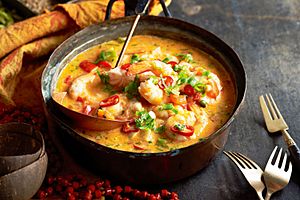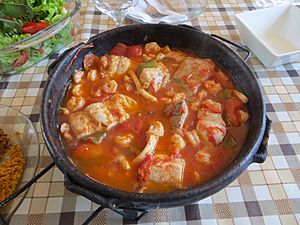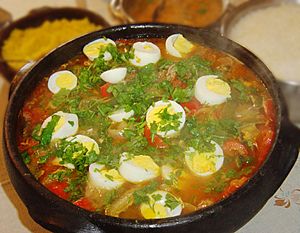Moqueca facts for kids

|
|
| Type | Stew |
|---|---|
| Place of origin | Brazil |
| Main ingredients | Seafood, fish or shrimp, onions, garlic, tomatoes, cilantro and coriander |
| Variations | Moqueca capixaba, Moqueca baiana |
Moqueca is a delicious Brazilian seafood stew. It's usually made with shrimp or fish, along with tomatoes, onions, garlic, lime, and a herb called coriander. The name 'Moqueca' comes from the Kimbundu language, which is spoken in Angola. People often eat Moqueca with 'banana da terra' (a type of cooking banana), 'pirão' (a thick sauce made from cassava flour), and white rice. Each part of the meal is often served in its own special clay pot.
Contents
Types of Moqueca
There are two main types of Moqueca: Moqueca capixaba and Moqueca baiana. Both are popular in Brazil, but they have some key differences.
Moqueca Capixaba: The Lighter Stew
Moqueca capixaba comes from the state of Espírito Santo in Brazil. This version mixes cooking styles from native Brazilians and the Portuguese. It's known for being a lighter and milder stew.
Instead of heavy oils, cooks use lighter oils like extra-virgin olive oil. They also add a natural color from a plant called urucum (also known as annatto). This gives the stew a nice reddish-orange color. Moqueca capixaba is always cooked in a traditional clay pot.
You can make Moqueca capixaba with different kinds of seafood, like fish, shrimp, crabs, or even lobsters. The full meal often includes stewed plantains, pirão (a thick sauce), and white rice. Each side dish is served in its own clay pot. The stew is usually seasoned with onion, tomatoes, coriander, and chives.
The Capixaba Clay Pot
The special clay pots used for Moqueca capixaba are called panelas de barro. They are made from black clay and glazed with sap from mangrove trees. After the pots are shaped and baked, more sap is put on them. This makes the clay black and helps it hold water. Before using a new pot, it needs to be "seasoned" a few times with oil.
These unique clay pots are very important to the city of Vitória. There's even a group of pot-makers called Associacao Das Paneleiras De Goiabeiras who keep this tradition alive.
Moqueca Baiana: The Richer Stew
Moqueca baiana was created in the state of Bahia, Brazil. This version has influences from African and Portuguese cooking. African traditions added dendê palm oil, which gives the stew a distinct orange color and flavor. Portuguese influence brought coconut milk to the recipe, making it creamy.
The main ingredients for Moqueca baiana are similar to other versions. It's often topped with fresh chopped coriander. People usually serve it with white rice and farofa, which is toasted cassava flour.
Moqueca in Popular Culture
Moqueca has become famous around the world. It was even shown on the Netflix TV series, Street Food. This show featured Moqueca in its second volume, which focused on delicious street foods from Latin America.
See also
 In Spanish: Moqueca para niños
In Spanish: Moqueca para niños



